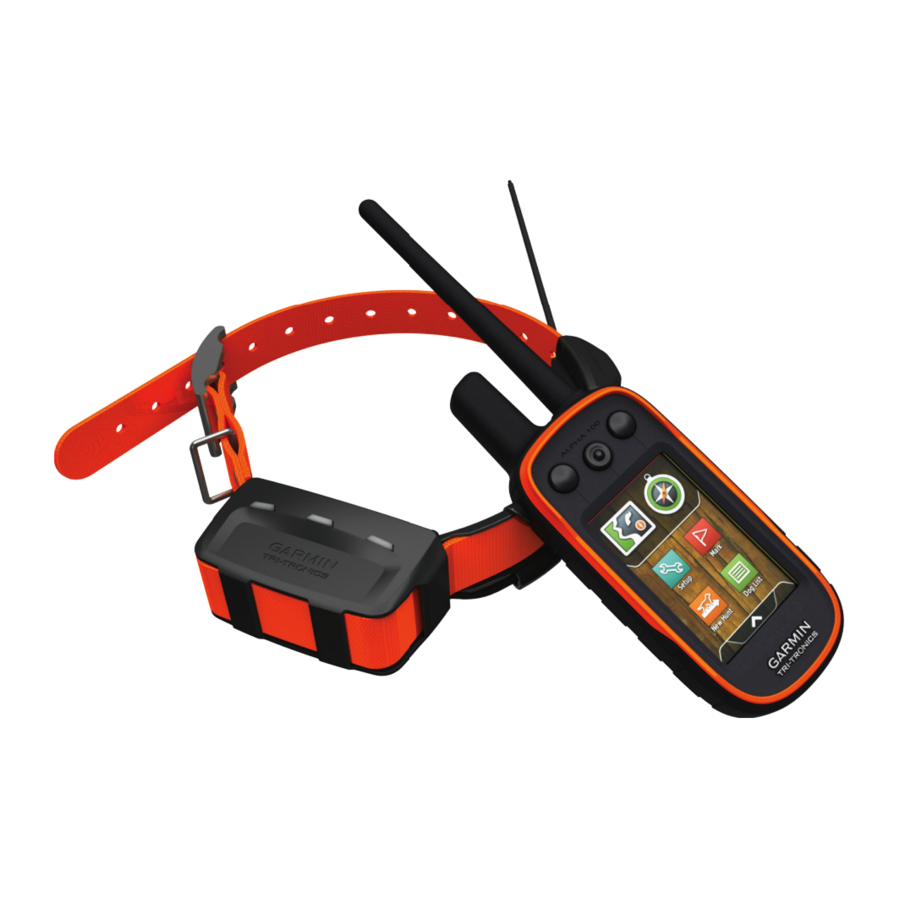Garmin Alpha 100 Manual del usuario - Página 21
Navegue en línea o descargue pdf Manual del usuario para GPS Garmin Alpha 100. Garmin Alpha 100 24 páginas. Multi-dog tracking gps
También para Garmin Alpha 100: Manual del usuario (26 páginas), Referencia rápida (2 páginas), Información sobre el producto (4 páginas), Manual del usuario (26 páginas), Manual del usuario (27 páginas), Manual del usuario (24 páginas)

2
Pry off the cover.
3
Remove the screw
securing the VHF antenna to the back
plate.
4
Pull the length of the antenna from the antenna guide to
remove the old antenna.
5
Loop the antenna guide around the collar strap, and thread
the new VHF antenna through the guide.
This helps to point the antenna up.
6
Replace the screw securing the VHF antenna to the back
plate.
7
Replace the cover over the VHF antenna.
8
Replace the 4 screws on the cover, replacing the short screw
in the correct location.
Changing the Fuse in the Vehicle Power Cable
When replacing the fuse, do not lose any of the small pieces
and make sure they are put back in the proper position. The
vehicle power cable does not work unless it is assembled
correctly.
If your device does not charge in your vehicle, you may need to
replace the fuse located at the tip of the vehicle adapter.
1
Rotate the end piece
unlock it.
TIP: You may need to use a coin to remove the end piece.
2
Remove the end piece, the silver tip
3
Insert a new fast-blow fuse that has the same current, such
as 1 A or 2 A.
4
Place the silver tip in the end piece.
5
Push in the end piece and rotate it 90 degrees clockwise to
lock it back into the vehicle power cable
Data Field Options
Accuracy of GPS: The margin of error for your exact location.
For example, your GPS location is accurate to within +/-
12 feet (3.65 m).
Ambient Pressure: The uncalibrated environmental pressure.
Ascent - Average: The average vertical distance of ascent
since the last reset.
Ascent - Maximum: The maximum rate of ascent in feet per
minute or meters per minute since the last reset.
Appendix
NOTICE
90 degrees counter clockwise to
, and the fuse
.
Ascent - Total: The total elevation distance ascended since the
last reset.
Barometer: The calibrated current pressure.
Battery Level: The remaining battery power.
Bearing: The direction from your current location to a
destination. You must be navigating for this data to appear.
Cadence: The revolutions of the crank arm or strides per
minute. Your device must be connected to a cadence
accessory.
Course: The direction from your starting location to a
destination. Course can be viewed as a planned or set route.
You must be navigating for this data to appear.
Descent - Average: The average vertical distance of descent
since the last reset.
Descent - Maximum: The maximum rate of descent in feet per
minute or meters per minute since the last reset.
Descent - Total: The total elevation distance descended since
the last reset.
Distance to Destination: The remaining distance to the final
destination. You must be navigating for this data to appear.
Distance to Next: The remaining distance to the next waypoint
on the route. You must be navigating for this data to appear.
Elevation: The altitude of your current location above or below
sea level.
Elevation - Maximum: The highest elevation reached since the
last reset.
Elevation - Minimum: The lowest elevation reached since the
last reset.
ETA at Destination: The estimated time of day you will reach
the final destination (adjusted to the local time of the
destination). You must be navigating for this data to appear.
ETA at Next: The estimated time of day you will reach the next
waypoint on the route (adjusted to the local time of the
waypoint). You must be navigating for this data to appear.
Glide Ratio: The ratio of horizontal distance traveled to the
change in vertical distance.
Glide Ratio to Dest: The glide ratio required to descend from
your current position to the destination elevation. You must
be navigating for this data to appear.
GPS Signal Strength: The strength of the GPS satellite signal.
Heading: The direction you are moving.
Heart Rate: Your heart rate in beats per minute (bpm). Your
device must be connected to a compatible heart rate
monitor.
Location (lat/lon): The current position in latitude and longitude
regardless of the selected position format setting.
.
Location (selected): The current position using the selected
position format setting.
Odometer: A running tally of distance traveled for all trips. This
total does not clear when resetting the trip data.
Off Course: The distance to the left or right by which you have
strayed from the original path of travel. You must be
navigating for this data to appear.
Pointer: An arrow points in the direction of the next waypoint or
turn. You must be navigating for this data to appear.
Speed: The current rate of travel.
Speed Limit: The reported speed limit for the road. Not
available in all maps and in all areas. Always rely on posted
road signs for actual speed limits.
Speed - Maximum: The highest speed reached since the last
reset.
Speed - Moving Avg.: The average speed while moving since
the last reset.
17
